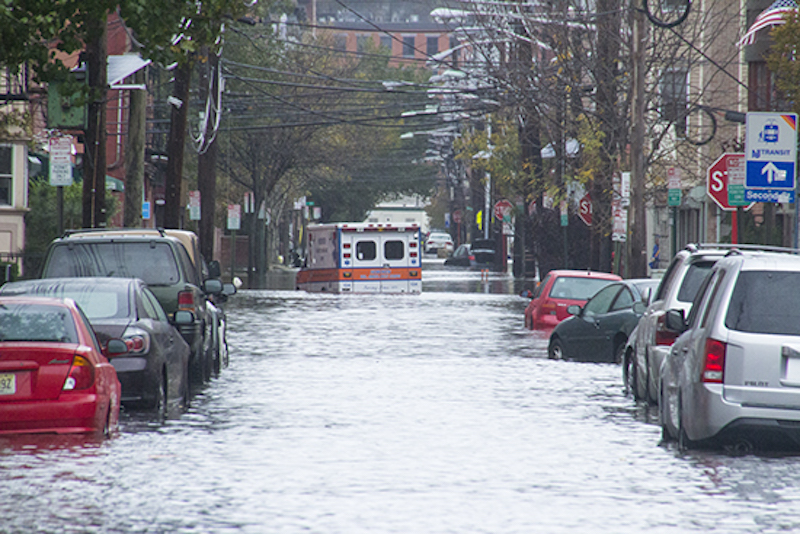AEC firms and their developer clients should be watching the progress of two bills wending their way through Congress that, if passed, could become important first steps toward opening the writing of flood insurance policies to private-sector carriers.
The U.S. House of Representatives recently passed HR 2901, the Flood Insurance Market Parity and Modernization Act of 2015, on a vote of 419-0. The U.S. Senate is currently reviewing similar legislation, SB 1679, on which it is expected to vote this summer.
The bills expand upon the controversial Biggert-Waters Flood Insurance Reform Act of 2012, which clarified the intent of Congress to get the private insurance sector to develop flood-insurance products that could compete with taxpayer-subsidized policies offered through the National Flood Insurance Program (NFIP).
That program is more than $23 billion in debt and has more than $1.1 trillion in total property exposure. NFIP’s main problem has been that it hasn’t been charging policyholders enough for flood coverage, explains Anthony Kammas, a partner with New York-based Skyline Risk Management, surety and insurance brokerage, who is also Secretary-Elect of the Professional Insurance Association (PIA).
Biggert-Waters called for the phasing out of subsidies and discounts on flood insurance premiums, and pushing more risk onto private-sector insurers and policyholders. Under Biggert-Waters, 5% of policyholders—including owners of non-primary private residences, business properties, and “severe repetitive loss properties” that are subject to redrawn floodplain maps—would have incurred 25% per year rate increases “until the true risk premium is reached.” Another 10% of policies would retain their NFIP subsidy until the owners sell their houses or let their policies lapse.
Policyholders screamed about those premium hikes, especially since the new maps put a lot more real estate within floodplains.
“It became clear that flood insurance needed to be repriced,” says Kammas. By the government agreeing ultimately to more gradual premium increases that would be priced using actuarial models, “private carriers started to think that they could make money on a primary basis.” Kammas adds that reinsurers are looking for places where they can put investors’ dollars to work.
Last month, PIA and a contingent of members spent two days on Capitol Hill meeting with lawmakers, including New York Sen. Chuck Schumer and New Jersey Sen. Robert Menendez, to urge them to support the bills that would open up the flood market to private carriers.
Kammas says the association’s goal is not to eliminate NFIP—“it will never disappear,” he says—but to make it the carrier of last resort. Kammas acknowledges that NFIP would be needed to provide flood insurance in flood-prone areas for which private carriers are less likely to offer policies. PIA also wants Congress to reauthorize the government flood program for 10 years, instead of annually, which the association believes would lend more stability to the marketplace.
Under NFIP’s “write your own” program, private carriers are allowed to service coverage that’s written by NFIP (Skyline does this). If the Senate passes SB 1679, the next step, says Kammas, would be to get private insurers engaged in offering their own flood-insurance products. (He could not provide names, but Kammas says a number of private insurers have policies that are ready to go.) The terms and conditions of such policies still need to be worked out, however, including their pricing.
“There’s a lot of work to be done, because there’s no historical information in place,” says Kammas.
He says AEC firms and developers need to be paying attention to how floodplains have been rezoned, and to make sure their policies are in compliance with their lenders’ requirements. They should also make sure that, in the event they choose to switch coverage to a private carrier, their current policies provide a continuity of coverage. And lastly, given how there’s no competitive pricing currently, policyholders would need to price-shop carefully to make sure they are getting the coverage that matches their needs at the lowest price.
Related Stories
| Apr 19, 2012
Michigan legislature tackling controversial rules on electricians
A fight is brewing in the Michigan legislature over how many fully qualified electricians must be present during electrical work when apprentices also are on hand.
| Apr 13, 2012
Congress’s action doesn’t mean Pentagon can’t build LEED gold structures
Though Congress passed a defense budget preventing the Department of Defense from spending money to achieve LEED gold or platinum certification, the Pentagon may still end up constructing buildings to those standards.
| Mar 1, 2012
California bill aims to cut costs for commercial building energy retrofits
A bill in the California Assembly would allow the state to pool together property owners’ energy-retrofit loans.
| Feb 23, 2012
Federal budget cuts put major building projects on hold
A plan to build the National Bio and Agro-Defense Facility in Kansas is among several major building projects in jeopardy after the Obama administration’s 2013 budget was unveiled. The budget would cut all construction spending for the facility.
| Feb 23, 2012
Federal agencies fixed on leasing LEED-certified space
The federal government is especially focused on renting LEED-certified spaces.
| Feb 23, 2012
Regulators investigating construction accident at World Trade Center
The New York Port Authority and the city’s fire and building departments are investigating an accident at the World Trade Center construction site in lower Manhattan after a crane dropped steel beams that fell about 40 stories onto the truck that delivered them.
| Feb 23, 2012
New Virginia statewide building code goes into effect March 1
After March 1, all building plans in Virginia must adhere to the 2009 code that was adopted a year ago.
| Feb 17, 2012
AGC advocates for federal procurement reform
Ensure that small business goals take into consideration actual small business capacity in relevant specialty markets.
| Feb 17, 2012
Codes not to blame for Anchorage roof collapses following heavy snows
Design or construction problems likely contributed to the collapses, according to city officials.
| Feb 17, 2012
OSHA training videos on proper respirator use available online
17 short videos to help workers learn about the proper use of respirators on the job.

















